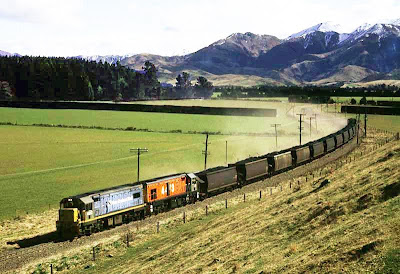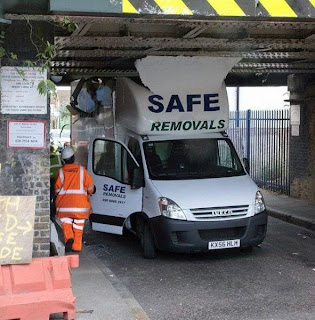Wednesday, February 29, 2012
ship Seebad Binz
A ship named after the Ostsee (Baltic Sea) town of Binz, and built in DDR days for the VEB Fahrgastschiffahrt "Weisse Flotte" (White Fleet) in Stralsund. In 1994 it was sold and has since changed hands a couple of times, most recently to Belgian owners in 2010.
Builder: VEB Schiffswerft "Edgar André", Magdeburg
Launched: 1957
Length: 42.95 metres
Beam: 7.62 metres
Draft: maximum 2.2 metres
Engines: 2 × SKL-6 NVD 36
Output: 540 hp
Speed: max. 11 knots (20 km/h)
Propellers: 2
Cargo capacity: 47 tonnes deadweight
Authorised Passengers: 440
1937 Morris 8
A car model that seems to follow us (see earlier posts)... In the left background is a 1938 Oldsmobile F38.
Finnish railway anniversary
A poster for the centenary advertising anniversary winter discounts. This year of course is the 150th anniversary.
1949 Morris Minor
A 2-door, 5-seater with a 1-litre engine. For the history of these cars and vans in NZ, see the book The New Zealand Morris Minor story.
the Academy Awards greenroom library
Every year Architectural Digest designs an exclusive backstage lounge for Oscar presenters and honorees. This year, that greenroom had a designer library, too. (Architectural Digest pic)
railway through the chestnut trees
A rather idyllic postcard from 1916 showing a level crossing and its keeper in the town of Villers-Cotterets in the heart of the Retz forest with the Passage des Chatagniers. The Latin name for chestnut tree Castanea is where the word castanets comes from.
Paris-Orléans car rally posters
The Chemin de Fer de Paris à Orléans was of course one of the pre-nationalisation French railway companies, here advertising places in the Haut-Quercy, presumably for rally spectactors.
traditional German fishing boat
At least that is the assumption from the title "Fischkutter". The signature looks like G. Fuurmann about whom no info shows up.
Tuesday, February 28, 2012
the SNCF 'Waterman'
The 5546-5550 (5 units) of the SNCF 2D2 class, for 1.5 kV DC, delivered from April 1942 to October 1943, had the nickname of 'Waterman' after the resemblance of the nose to a well-known ink-bottle, but from a technical viewpoint, an interesting feature was the use of Buchli drive.
In a Buchli drive a driven gear wheel is securely fixed to the locomotive frame. Inside this gear wheel are two levers, coupled to gear segments that mesh with one another. The other end of the levers is coupled via universal joints to tension bars, which are then coupled via more universal joints to the driving rail wheel. Vertical movement of the driving wheel results in the gear segments moving due to the internal mechanism, and the driving wheel can move in a horizontal or vertical direction with respect to the gear wheel, while still transferring the momentum of the gear wheel. See diagram.
A disadvantage of the drive was the large number of moving parts, which demanded frequent lubrication and careful maintenance. The Buchli drive system was mainly used on express train locomotives, as there were no other drive systems that gave the same performance at high speeds. However, at higher speeds the drive components became unbalanced, causing issues at speeds over 140 km/h. See also the post about the femme enceinte.
canal boat haulers
Traditionally horses did this but maybe these two boys are doing it as a punishment. We think this card is French.
the shark bus
Yes, it would be ideal transport for bnz employees, but it is actually owned by the Kelly Tarlton Underwater World experience (calling it an aquarium doesn't do it justice). website
Bus details
2005 Toyota CoasterNumber of seats: 23
Engine size: 4,000 cc
Fuel type: Diesel
Country of origin: Japan
Gross vehicle mass: 5.5 tonnes
Tare weight: 3.6 tonnes
Maximum rated towed mass: 750kg (for unbraked trailer) and 3,000 kg (for braked trailer)
No of axles: 2
Wheelbase: 3,940 mm
marine activity of old near Tower Bridge, London
A painting by Keith Snow, whose homeland is obvious, but for the last three decades he has lived in Auckland. More of his works for sale are on this webpage.
Citroen DS and Ami 6 take the night train, 1960s
...while the owners make use of a sleeping car of the Compagnie Internationale des Wagon Lits. STVA = Société de Transport de Véhicules Automobiles, a subsidiary of the SNCF, and operates in 9 European countries, founded in 1950
1930 Chrysler CJ Six roadster convertible
Is the rumble seat designed for the wife when you pick up that hot hitchhiker who goes beside you, so she can't overhear your conversation with her?
London theme
What could be more representative than a British 'bobby' and a red AEC double-deck RT? Well at least that was the case 50 years ago.
in the Pas de Calais, France, 1950s
The station at Billy Montigny showing a Delahaye bus at the railway station.
At Merlimont Plage with a Chausson bus of Les Transports Westeel. One notes a 1951 Ford Vedette (American designed, French manufactured) parked at the far left, see below.
Nicaragua railway stamps, 1983
Actually Nicaragua is a country Steven Joyce should enjoy as today it has no operating railways. The majority of lines were closed in 1993, the last one in 2001.
Narrow gauge railways had been built there since 1878 on the Pacific coast. First was a Western division (from Corinto to Puerto Momotombo at Lake Managua, passengers to Managua had to change to a steamboat), then the Eastern division from Managua to Granada and finally a Central division connecting these two (thus eliminating the need for steamboats). In the following years, several branch lines were built. There were attempts to connect both coasts, but they all failed; except for a few isolated lines in the North, almost all of the network was in the Pacific basin. In 1993 there was 373 km (228 miles) of 1,067 mm (3'6") narrow gauge tracks in the Pacific region and an isolated 3 km of 1,435 mm (standard gauge) line at Puerto Cabezas in the Caribbean. Most lines were shut down on 31 December 1993. The last one - 6 km from Chichigalpa to Ing. S. Antonio - was decommissioned in September 2001.
the Panama Canal - the greatest civil engineering project in history
A two-hour program on the History Channel a few days ago looked at this, and it made you realise what a mammoth undertaking it was, all funded and supervised by the US Government. Lesser known aspects include the decision to kill all mosquitoes in the canal zone to stop yellow fever which was killing off lots of the (mainly West Indian) workers.
You wonder what the attitude of Congressional Republicans - who don't even want money spent on a few high speed rail lines - would be today.
Subscribe to:
Comments (Atom)
















































